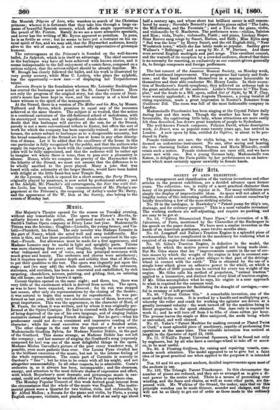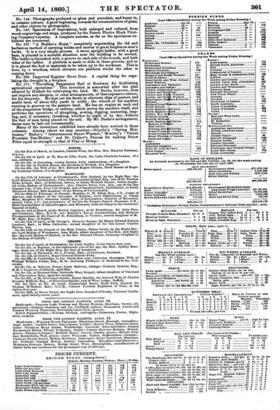fin lrts.
SOCIETY OF ARTS EXHIBITION.
The arrangement and classification of the various inventions and other articles in the present exhibition, are a decided advance upon former years. The collection, too, is really of a more practical character than many of its predecessors. We rejoice at it. Too many exhibitions are simply the display of impracticable ideas. As space will not admit of a lengthy notice of this interesting collection, we shall content ourselves by briefly describing a few. of the more striking articles.
No. 20 in the catalogue, is Hawksley's " Patent pump for ship's use, drainage, and for ordinary purposes." This is a most valuable invention. The working surfaces are self-adjusting, and require no packing, 'and are easy to be got at. . No. 19, "Patent Bitumenized Paper Pipes," the invention of a M. Jaloureau, of Paris, mentioned by the Chancellor of the Exchequer in his speech on the paper duties. We have seen a similar invention in the hands of an American gentleman, some twelve months since. No. 32. Longstaff and Pallan's Traction Engine is a splendid piece of workmanship, but too complicated in the machinery for realizing what is required of an engine for common roads.
No. 33. Giles's Traction Engine, is defective in the model, the method by which the motive power is applied not being made clear. But Mr. Giles states that his " improvements consist in the use of cer- tain means by which the weight of the engine is kept in constant sus- pension (while in action) at a point oblique to that part of the driving- wheel in contact with the earth." This is obtained by the use of a simple lever which gives an adhesive power to the wheel, on which a tractive effort of 2000 pounds can be exerted for every ton weight of the engine. Mr. Giles calls his method of propulsion, "animal traction applied to a locomotive, and distinct from every kind of traction-engine. If Mr. Giles accomplishes what he says, his engine is a near approach to what is required for the common road.
No. 34 is an apparatus for facilitating the draught of carriages,—use- ful in swampy or soft grounds.
No. 60. ",Patent Cotton Gin." A remarkable invention, one of the most useful in the room. It is worked by a handle and multiplying gear, whereby the roller and crank for working the agitator are driven at .a increased ncreased velocity : the work turned off by the machine being in direct proportion to the speed obtained. One man only is required to work it ; and he will turn off from 5 to 6lbs. of clean cotton per hour. The process leaves the staple or fibre uninjured, the seeds being whole or uncrushed, and well cleaned. No. 61. Yahn's "Patent Machine for making covered or Plated Twist or Cord," a most splendid piece of machinery, capable of performing five operations at the same time. This valuable invention was noticed at length in the Spectator of April 23, 1859. No. 77. O'Neill's Patent Universal Spanners, will be found not only by engineers, but by all who have a carriage-wheel to take off or screw on, to be most useful.
No. 80. A Floating Gridiron, for raising and repairing vessels, com- mands much attention. The model appeared to us to give but a faint idea of its great practical use when applied to the purposes it is intended for.
Nos. 93 and 94 are patent anchors, decided improvements upon most of the anchors in use.
No. 133. The Triangle Patent Timekeeper. In this chronometer the number of pieces are reduced, and they are so arranged as to give a di- rect power to the centre wheel. There is a means of preventing over winding, and the fusee and chains, as well as some other parts, are dis- pensed with. Mr. Watkins of the Strand, the maker, says that on this principle watches can be made thinner, sounder and 'cheaper, and they will not be so likely to get out of order as those made in the ordinary way.
No. 144; Photographs produced on glass and porcelain, and burnt in, in ceramic colours. A good beginning, towards the ornamentation of glass, and other objects by photography. No. 145. Specimens of impressions, both enlarged and reduced, from wood-engravings and maps, produced by the Patent Electro Block Print- ing Company's system. A complete success, as far as the specimens ex- hibited are concerned.
No. 197. "A Builder's Hoist," completely superseding the old and barbarous method of carrying bricks and mortar to great heights on men's backs. It is a very simple process. A stout, upright ladder, with a good base, is planted in a suitable situation near the building to be erected. The ladder is furnished with a groove on each aide of the rounds, and both sides of the ladder. A platform is made to slide in these grooves, and on it is placed the hod or materials to be taken up to the workmen. This is done by a windlass, which elevates one platform whilst the other is coming down.
No. 266. Improved Register Stove Door. A capital thing for regu- lating the draught in a fireplace.
No. 171. "Travelling Suspension Rail or Roadway for facilitating agricultural operations." This invention is somewhat after the plan adopted by Ralkett for cultivating the land. Mr. Banks, however, does not require any sleepers, or other arrangements, of that expensive nature, for his tramway. He lays out his farms in alternate slips of pasture and arable land, of about fifty yards in width ; the wheels of his machine running in grooves on the pasture land. He has an engine at each end of the suspension bridge, or railway, which moves the machine itself, and performs the operations of ploughing, sowing, digging, manuring, reap- ing, and, if necessary, thrashing, whether by night or by day, without the foot of man being placed on the soil. By Mr. Banks's arrangement, farms may be laid out ornamentally.
Many of the inventions exhibited have already been noticed in these columns. Among others we may mention-Geyelin's "Spring Mat- tresses," Bailey's "Instantaneous Razor-Warmer," Moseley's "Patent Fountain Pen-Holder," and Dr. Collyer's Process for making Straw Fibre equal in strength to that of Flax or Hemp.



























 Previous page
Previous page